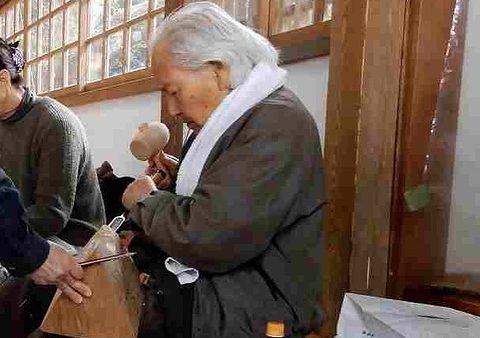In this article, there is about the 7th president’s younger brother, Chozan Koshimizu, a shrine wooden carver and Buddhist Monk, who passed away at August 2022.


In fact, He made wood carvings of many shrine and temple especially Hakone Shrine.
In his later years, he held a wood carving class in the mountains and taught many people.
(This article is written by the 9th fisrtson)
About Chozan Koshimizu, a Wood carver and Buddhist Monk
He was born in 1938 as younger brother of Haruo Koshimizu, the 7th president. and he was adopted by Hanzo Koshimizu, the 6th.
According to Chozan, there was no instruction regarding woodworking. And he learned about wood carving by himself. He also trained at temples and played the conch shell as Buddhist Monk .
After that, requests for wood carvings increased due to the rebuilding of shrines and temples after world war Ⅱ with his disciples. they created a variety of sculptural works.
Relationship with our company
In collaboration with his 8th president, Shigeru Koshimizu, he has also made many wooden doors and furniture for private residences.
It is also an achievement of him that he discovered that the Koshimizu families continued from the shrine carpenter.
When we did some wood carving and doors at Afuri Shrine in Isehara City, Kanagawa Prefecture, we discovered the words “Koshimizu Daitoryo” written inside the shrine, it proves we are from shrine carpenter.
Relationship with our company
Wood carving instruction
Main Advice for Carving wooden Buddha statue
A Student has collected and listed the main words that He usually taught to everyone in the classroom. He usually jokes and has a gentle smile, but once he starts to make the Buddha statue, the expression on his face suddenly changes and her eyes light up. He always praises one made by students first and then checks it.
(1) Carve with all your heart
Many people tend to prioritize technical aspects, but the heart is the first priority.
(2) Carve carefully,
you can be not good, but be careful
(3) Carve it what everyone thinks good
(4) Able to Carve with your individuality
(5) No competition.
(6) Carve with Dynamic.
(7) Express the power of claiming by Buddhist statues
(8) Be aware of the naked lines of the body (Budda statue clothed on the naked)
(9) be the same size and the corrected position of the left and right sides of the eyes, nose, mouth, ears, hands and feet
(10) Be balanced of the entire image of statue
Beginners usually don’t understand the difference even if he pointed it out. And He doesn’t use glasses and his eyesight is excellent even over 90 years old.
(10) Carve Feet more carefully
because feet is more difficult than the face
(11) Made a drawing before carving
(12) Draw the center lines of vertical and horizontal (vertical lines are thick, with front, back, left and right).
If it disappears, write it again (for checking symmetry and standards)
(13)Carve the head of the statue on the top side of the tree
(14) be able to carve it yourself when you complete three.
(15) There are mainly 32 characteristics of the statues of Tathagatas and Bodhisattvas (further subdivided into eighty ones).
He always strongly insisted on “Carving with all your heart” and “you can be not good ,but be careful’.
translated by the japaese blog of student in his classroom
introduction-of-carving-buddah-statu(red-dragonfly-Ashigara)